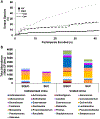Urinary microbiota of women with recurrent urinary tract infection: collection and culture methods
- PMID: 33852041
- PMCID: PMC8514570
- DOI: 10.1007/s00192-021-04780-4
Urinary microbiota of women with recurrent urinary tract infection: collection and culture methods
Abstract
Introduction and hypothesis: Many clinicians utilize standard culture of voided urine to guide treatment for women with recurrent urinary tract infections (RUTI). However, despite antibiotic treatment, symptoms may persist and events frequently recur. The cyclic nature and ineffective treatment of RUTI suggest that underlying uropathogens pass undetected because of the preferential growth of Escherichia coli. Expanded quantitative urine culture (EQUC) detects more clinically relevant microbes. The objective of this study was to assess how urine collection and culture methods influence microbial detection in RUTI patients.
Methods: This cross-sectional study enrolled symptomatic adult women with an established RUTI diagnosis. Participants contributed both midstream voided and catheterized urine specimens for culture via both standard urine culture (SUC) and EQUC. Presence and abundance of microbiota were compared between culture and collection methods.
Results: Forty-three symptomatic women participants (mean age 67 years) contributed specimens. Compared to SUC, EQUC detected more unique bacterial species and consistently detected more uropathogens from catheterized and voided urine specimens. For both collection methods, the most commonly detected uropathogens by EQUC were E. coli (catheterized: n = 8, voided: n = 12) and E. faecalis (catheterized: n = 7, voided: n = 17). Compared to catheterized urine samples assessed by EQUC, SUC often missed uropathogens, and culture of voided urines by either method yielded high false-positive rates.
Conclusions: In women with symptomatic RUTI, SUC and assessment of voided urines have clinically relevant limitations in uropathogen detection. These results suggest that, in this population, catheterized specimens analyzed via EQUC provide clinically relevant information for appropriate diagnosis.
Keywords: Enhanced urine culture; Recurrent urinary tract infection; Urinary microbiome; Urinary pathogen detection; Urine collection.
© 2021. The International Urogynecological Association.
Figures

Similar articles
-
The Clinical Urine Culture: Enhanced Techniques Improve Detection of Clinically Relevant Microorganisms.J Clin Microbiol. 2016 May;54(5):1216-22. doi: 10.1128/JCM.00044-16. Epub 2016 Mar 9. J Clin Microbiol. 2016. PMID: 26962083 Free PMC article.
-
Recurrent urinary tract infection: Association of clinical profiles with urobiome composition in women.Neurourol Urodyn. 2021 Aug;40(6):1479-1489. doi: 10.1002/nau.24707. Epub 2021 May 26. Neurourol Urodyn. 2021. PMID: 34036621 Free PMC article.
-
A Randomized Clinical Trial of Standard versus Expanded Cultures to Diagnose Urinary Tract Infections in Women.J Urol. 2021 Nov;206(5):1212-1221. doi: 10.1097/JU.0000000000001949. Epub 2021 Jun 29. J Urol. 2021. PMID: 34184930 Clinical Trial.
-
Clinical relevance of expanded quantitative urine culture in health and disease.Front Cell Infect Microbiol. 2023 Aug 1;13:1210161. doi: 10.3389/fcimb.2023.1210161. eCollection 2023. Front Cell Infect Microbiol. 2023. PMID: 37593764 Free PMC article. Review.
-
Utility of DNA Next-Generation Sequencing and Expanded Quantitative Urine Culture in Diagnosis and Management of Chronic or Persistent Lower Urinary Tract Symptoms.J Clin Microbiol. 2019 Dec 23;58(1):e00204-19. doi: 10.1128/JCM.00204-19. Print 2019 Dec 23. J Clin Microbiol. 2019. PMID: 31619534 Free PMC article. Review.
Cited by
-
Comparative genomic analysis of clinical Enterococcus faecalis distinguishes strains isolated from the bladder.BMC Genomics. 2023 Dec 7;24(1):752. doi: 10.1186/s12864-023-09818-z. BMC Genomics. 2023. PMID: 38062354 Free PMC article.
-
Draft genomes of one Staphylococcus haemolyticus and five Staphylococcus lugdunensis strains isolated from catheterized urine samples of females.Microbiol Resour Announc. 2024 Sep 10;13(9):e0049724. doi: 10.1128/mra.00497-24. Epub 2024 Aug 20. Microbiol Resour Announc. 2024. PMID: 39162452 Free PMC article.
-
Rapid and accurate testing for urinary tract infection: new clothes for the emperor.Clin Microbiol Rev. 2025 Mar 13;38(1):e0012924. doi: 10.1128/cmr.00129-24. Epub 2024 Dec 6. Clin Microbiol Rev. 2025. PMID: 39641639 Review.
-
Cataloging variation in 16S rRNA gene sequences of female urobiome bacteria.Front Urol. 2024 Jan 8;3:1270509. doi: 10.3389/fruro.2023.1270509. eCollection 2023. Front Urol. 2024. PMID: 40778067 Free PMC article.
-
Draft genomes of Klebsiella aerogenes, Klebsiella huaxiensis, and Klebsiella michiganensis isolates from the urinary tract.Microbiol Resour Announc. 2024 Sep 10;13(9):e0049224. doi: 10.1128/mra.00492-24. Epub 2024 Aug 20. Microbiol Resour Announc. 2024. PMID: 39162486 Free PMC article.
References
-
- Aslam S, Albo M, Brubaker L. Recurrent urinary tract infections in adult women. JAMA. 2020;323(7):658–659. - PubMed
-
- Gaitonde S, Malik RD, Zimmern PE. Financial burden of recurrent urinary tract infections in women: a time-driven activity-based cost analysis. Urol. 2019;128:47–54. - PubMed
-
- Haylen BT, de Ridder D, Freeman RM, Swift SE, Berghmans B, Lee J, Monga A, Petri E, Rizk DE, Sand PK, Schaer GN. An International Urogynecological Association (IUGA)/International Continence Society (ICS) joint report on the terminology for female pelvic floor dysfunction. International Urogynecology J, 2010,21:5–26. - PubMed
-
- Kass EH. Asymptomatic infections of the urinary tract. Trans Assoc Am Physicians. 1956;69:56–64. - PubMed
-
- Kass EH. Bacteriuria and the diagnosis of infections of the urinary tract; with observations on the use of methionine as a urinary antiseptic. AMA Arch Intern Med. 1957;100(5):709–714. - PubMed
MeSH terms
Grants and funding
LinkOut - more resources
Full Text Sources
Other Literature Sources
Medical

